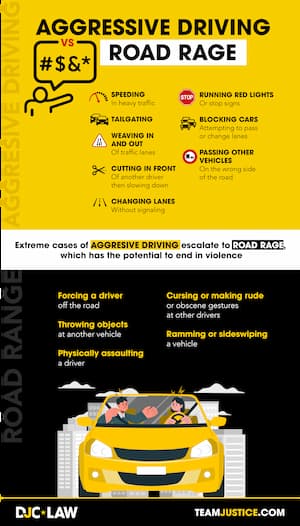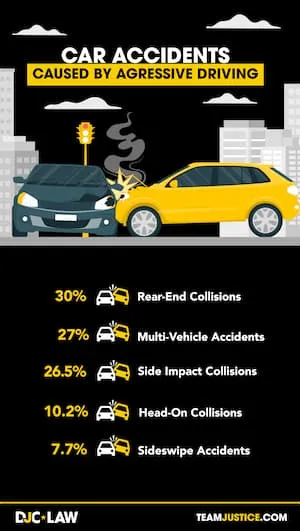The routine pressures of daily life, including work responsibilities, interpersonal dynamics, time constraints, and financial concerns, can take a significant toll on individuals, including those who typically exhibit excellent anger management skills.
When you add the additional stress of navigating through bustling traffic, even a seemingly simple situation, such as a vehicle traveling below the posted speed limit, may trigger aggressive driving.
However, there is never an excuse for this type of behavior behind the wheel. It puts everyone at risk. If you were in a car accident and suspect or know that it involved aggressive driving or road rage, discuss your accident with a skilled Austin auto accident lawyer as soon as possible. An attorney can protect your rights and inform you of your options.
What Causes Aggressive Driving and Road Rage?
Given the inherent risks associated with driving, it’s only natural for tension to arise. This heightened state often leads to an increase in drivers’ heart rates and the tightening of muscles. The resulting stress leaves drivers more susceptible to experiencing intense emotions, such as anger, especially when faced with provocation.
One study revealed that aggressive drivers tend toward more impulsive reactions, frequent outbursts of anger, and a more assertive expression of their emotions. These drivers are also inclined to engage in behaviors such as speeding, tailgating, and rapid lane changes and are involved in more accidents. Paradoxically, they tend to be more critical of the driving behaviors of others.
When coupled with the sense of power, privacy, and perceived safety provided by the confines of a vehicle, this anger-driven conduct leads many otherwise rational drivers to make hasty and risky decisions while on the road.
Moreover, due to the fact that most drivers remain unknown to each other, it becomes easier for irate drivers to negatively label anonymous fellow motorists and form assumptions about their character and intentions.
Aggressive Driving vs. Road Rage

Generally speaking, aggressive driving is any unsafe behavior performed purposely with ill intent or disregard for safety that puts other drivers, their passengers, or their property at risk.
Examples of aggressive driving include:
- Speeding in heavy traffic
- Tailgating
- Weaving in and out of traffic lanes
- Cutting in front of another driver, then slowing down
- Changing lanes without signaling
- Running red lights or stop signs
- Blocking cars attempting to pass or change lanes
- Passing other vehicles on the wrong side of the road
Extreme cases of aggressive driving escalate to road rage, which has the potential to end in violence. Some road rage behaviors (other than shouting or inappropriate gesturing) are criminal offenses in Texas. Examples of road rage include any of the following behaviors.
Cursing or making rude or obscene gestures at other drivers
- Ramming or sideswiping a vehicle
- Forcing a driver off the road
- Throwing objects at another vehicle
- Physically assaulting a driver
Is Road Rage a Criminal Offense in Texas?
In Texas, while road rage itself is not a distinct criminal offense, behaviors associated with aggressive driving, like tailgating or reckless driving, can lead to legal consequences under existing traffic laws.
For instance, Texas considers reckless driving a criminal offense, with potential penalties including fines, license suspension, or even imprisonment in some instances.
The exact sanctions for reckless driving hinge on various factors, including the level of danger imposed on other drivers, the driver’s prior record, and whether any injuries or fatalities resulted from the incident.
Likewise, acts of aggressive driving, such as tailgating or making unsafe lane changes, can be addressed as traffic violations in Texas, potentially resulting in fines and the accumulation of points on the driver’s license. Repeat offenders may face the prospect of license suspension or revocation.
Should road rage behaviors escalate to physical violence, such as assault or battery, they can be subject to prosecution as criminal offenses in Texas. Penalties vary based on the severity of the offense, ranging from fines to imprisonment.
Criminal vs. Civil Cases
No matter if the aggressive driver who caused your accident faces criminal charges or not, you have the right to pursue a civil case to recoup your losses and damages.
Criminal and civil cases can run concurrently, but they don’t depend on each other. However, since a criminal case has a stricter burden of proof than a civil case if the driver is found guilty of criminal charges, this will lend itself to your civil claim.
While you can get assistance for your medical bills or other losses through the jurisdiction’s victim’s compensation fund, it won’t cover all of your losses. Seeking compensation through a claim and potential civil lawsuit is the best chance you have at financial recovery after being in an accident with an aggressive driver.
Damages Resulting From Aggressive Driving Behaviors or Road Rage
Being in a car accident can negatively impact your life in many ways, from your finances to how you feel both physically and emotionally. Car accident damages are the financial representation of these negative impacts. While receiving money for damages can’t fix what has happened, it is the best way possible to make up for it.
Compensable damages include both economic or special and non-economic or general damages.
Economic damages represent your financial losses arising from the accident and can include:
- Property damage
- Past and future medical expenses and bills
- Past and future lost income
Receipts, bills, and income loss statements typically serve as evidence for these types of damages. On the other hand, non-economic damages can be more challenging to prove. These types of damages don’t have inherent value. Since they are subjective, they can also be tricky to prove.
However, these damages include:
- Pain and suffering
- Mental anguish
- Humiliation
- Loss of consortium
- Loss of enjoyment of life
- Scarring and disfigurement
Certain types of car accident claims can also involve punitive damages. Only the court has the authority to award punitive damages. They apply to cases where the at-fault party’s actions that caused the accident were incredibly reckless or wanton.
For instance, drunk driving cases may qualify for punitive damages. Instead of compensating a victim for their injuries, punitive damages aim. Many aggressive driving or road rage accidents may qualify for punitive damages since the behavior was especially careless and deliberate.

Types of Car Accidents Caused by Aggressive Driving
Aggressive driving can cause all types of different car accidents. While some might seem minor, they can still lead to severe or even debilitating injuries.
Side Impact Collisions
Side-impact collisions, also known as T-bone or broadside accidents, occur when the front of one vehicle collides with the side of another. The side of a vehicle has less mass to absorb the force of impact compared to the front and back, endangering the occupants of the struck vehicle. They account for a significant portion of motor vehicle fatalities, and often take place at intersections due to disregarded stop signs or red lights.
Distraction, intoxication, aggression, and reckless driving increase the risk of causing a side-impact collision, which can result in severe injuries even at low speeds.
Sideswipe Accidents
Sideswipe accidents happen when two vehicles travel parallel, and one impacts the side of the other. These often occur due to drivers neglecting to check their blind spots before merging or changing lanes.
Speeding, distraction, impairment, and recklessness can also contribute. While seemingly minor, these accidents can lead to loss of control and subsequent collisions with other vehicles, cyclists, pedestrians, or roadside objects, resulting in severe injuries.
Rear-End Collisions
Rear-end collisions often result from inattentiveness or tailgating. Failing to maintain a safe following distance can lead to accidents when traffic suddenly stops.
While the rear driver usually causes the accident, the lead driver may share responsibility if they stop abruptly or engage in unexpected maneuvers. Injuries can range from minor to catastrophic, even at low speeds.
Minor or no visible damage in a rear-end accident doesn’t negate the importance of reporting the incident to law enforcement. Symptoms of injuries may take time to manifest, so get prompt medical attention. Additionally, you will want a mechanic to perform a thorough vehicle inspection to identify all of its damage.
Head-On Collisions
Head-on collisions, while less frequent, are among the most dangerous accidents. They involve vehicles moving toward each other, intensifying the force of impact. Although they account for a smaller percentage of total crashes, they are responsible for a significant portion of traffic fatalities. These collisions often result from negligence, such as veering into oncoming traffic due to various factors, including reckless driving, intoxication, drowsiness, or distraction.
Multi-Vehicle Accidents
Multi-vehicle accidents involving three or more vehicles can lead to high insurance payouts. With multiple victims and various insurance policies involved, seeking fair compensation can be complex. A qualified car accident attorney can play a crucial role in ensuring victims receive the compensation they deserve.
Which Aggressive Driving Crashes Put Us at The Greatest Risk?
These types of accidents put motorists, their passengers, and others sharing the road at the greatest risk when it comes to aggressive driving:
- A rear-end accident caused by an aggressive driver following too closely (tailgating) behind another motorist
- Colliding head-on or being sideswiped by an aggressive driver going well above the speed limit
- Colliding with an aggressive driver who has run a red light or stop sign
- Being the passenger of an aggressive driver who gets into a serious accident
Potential Injuries Arising from Road Rage Accidents
Brain Injuries
Traumatic Brain Injuries (TBIs) involve bruising, bleeding, or tearing within the brain, potentially leading to serious and life-threatening consequences. Symptoms encompass memory issues, difficulty concentrating, sleep disturbances, and disruptions in both brain and bodily functions.
These injuries can cause enduring alterations in movement, sensation, personality, and cognitive abilities. They may also lead to persistent seizures, frequent headaches, depression, or other significant mental health conditions.
Back Injuries
Back pain is among the most debilitating types of discomfort individuals can experience. It has the potential to lead to severe and long-lasting disability, preventing individuals from returning to work.
Common types of back injuries include:
- Strains (often referred to as a pulled back, or damage to tendons and muscles)
- Sprains (involving stretching or tearing of ligaments)
- Slipped/herniated discs (where vertebrae shift and push sensitive inner tissue beyond their protective enclosure)
- Ruptured discs (in which the tissue between damaged vertebrae ruptures
- Offering less cushioning between bones), pinched nerves (resulting in sharp pain and limited mobility due to nerve compression)
- Nerve damage (causing debilitating and excruciating pain)
Burns
Contact with hot engine parts, scalding steam, or splashing liquids can lead to severe burns. Fires can result in fatal or life-threatening burns over extensive areas of the body.
Burns can range from minor to highly serious, contingent on the affected body area and depth of tissue involvement. Severe burns may necessitate skin grafts, cause persistent scarring, and carry complications like infections.
Internal Bleeding
Blunt force trauma that doesn’t break through the skin can lead to internal bleeding and other internal injuries. While these injuries might not immediately manifest, they constitute a primary reason for anyone involved in a major accident to promptly seek emergency medical attention, even if they appear unharmed and show no immediate symptoms.
Pain and Distress
Emotional distress and physical pain can persist long after a car accident. Conditions like depression and anxiety are common and can significantly impact daily life and sleep patterns. Pain may restrict various routine activities, potentially diminishing overall life satisfaction.
Broken Bones
Fractures and breaks in bones can result from a wide array of car accidents. Sometimes, they might not be immediately apparent after the incident. Pain, immobility, and other symptoms may arise later. Depending on the location and severity of the fracture, treatment can involve months of immobilization, surgical intervention, and physical therapy.
Facial Injuries

Facial injuries present unique challenges, given the presence of vital organs like the brain and major sensory organs. Scarring from facial injuries can physically and emotionally distress a victim.
An accident may damage the eyes, nose, mouth, and ears. These injuries may include bone fractures, deep lacerations requiring stitches or surgery, eye injuries with the potential for blindness, injuries to soft tissues like cartilage and tendons, and tooth loss necessitating dental work and prosthetics.
Neck Injuries
Any abrupt or jarring motion to the body can result in injuries to the neck’s muscles, tendons, cartilage, and other soft tissues. Whiplash, a condition arising from rapid forward and backward neck movement, may take months to heal or lead to chronic pain in rare cases.
If you suffered an injury in a car accident involving an aggressive driver or road rage, stand up for your rights by contacting an experienced personal injury lawyer right away.


